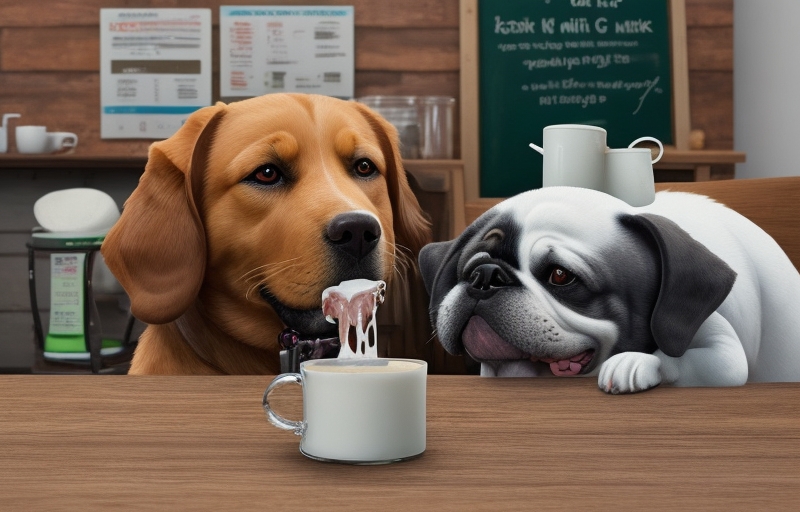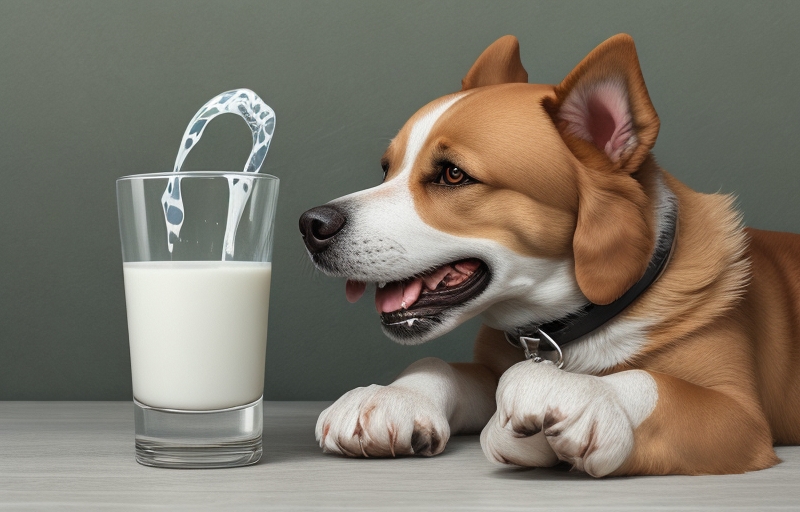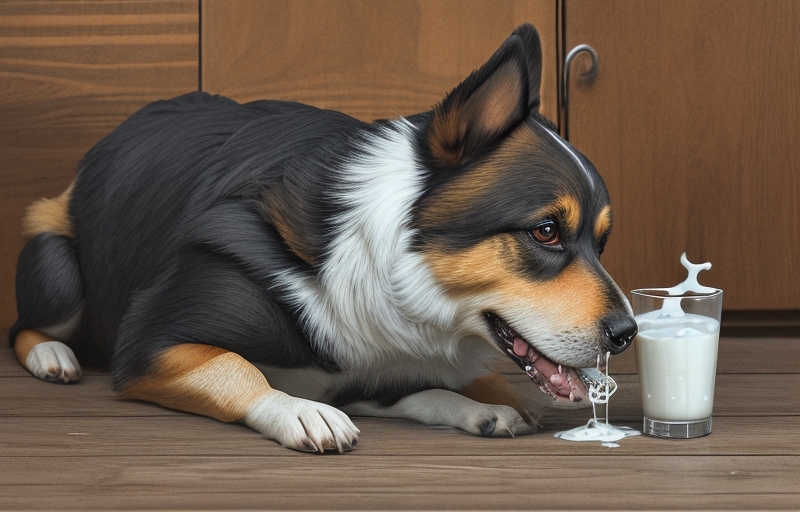Explore the pros and cons of offering hot milk to your dog. Learn about Should Dogs Drink Hot Milk? the potential benefits, such as hydration and a calming effect, along with drawbacks like lactose intolerance and the risk of burns. Make an informed decision for your furry friend’s well-being.
Introduction
Many pet owners love to pamper their furry friends, and offering them special treats is a common practice. One question that often arises is whether dogs can safely consume hot milk. In this article, we will delve into the benefits and drawbacks of giving hot milk to dogs, helping you make an informed decision about this indulgence for your canine companion.
Should Dogs Drink Hot Milk?
Benefits of Offering Hot Milk to Dogs:

Nutritional Value:
Hot milk contains essential nutrients such as calcium, protein, and vitamins. These components contribute to your dog’s overall health, promoting strong bones, muscles, and a shiny coat.
Hydration:
Dogs may sometimes be reluctant to drink water, especially during colder weather. Offering hot milk can be an enticing alternative, ensuring that your dog stays adequately hydrated.
Digestive Aid:
Warm liquids, like hot milk, can have a soothing effect on a dog’s digestive system. This can be particularly beneficial for dogs with upset stomachs or digestive issues.
Calming Effect:
The warmth of hot milk can have a calming effect on dogs, similar to how it might be comforting for humans. This can be especially helpful for anxious or stressed dogs, promoting relaxation.
Enhanced Appetite:
Some dogs may experience a loss of appetite due to illness or other factors. Offering hot milk can stimulate their sense of smell and taste, making them more inclined to eat.
Drawbacks of Offering Hot Milk to Dogs:

Lactose Intolerance:
Many dogs are lactose intolerant, meaning they lack the enzyme needed to properly digest lactose found in milk. This can lead to digestive issues such as diarrhea, stomach cramps, and gas.
Obesity Risk:
Milk, even in its hot form, can be calorie-dense. Regular consumption without proper adjustments to the dog’s overall diet can contribute to weight gain and obesity, leading to various health problems.
Allergic Reactions:
Dogs, like humans, can have allergic reactions to certain foods. While rare, some dogs may be allergic to components in milk, leading to symptoms such as itching, swelling, or respiratory issues.
Interference with a Balanced Diet:
Dogs require a balanced diet formulated for their specific nutritional needs. Excessive consumption of hot milk without considering its impact on the overall diet may lead to nutritional imbalances.
Risk of Burns:
The “hot” in hot milk poses a risk of burns to a dog’s mouth and throat. Dogs may not be able to gauge the temperature and may accidentally burn themselves while trying to consume hot milk.
Things To Consider Before Offering Hot Milk To Dog

Using hot milk for a dog requires careful consideration and attention to their individual needs. Here are some guidelines to keep in mind before offering hot milk to your furry friend:
1.Check for Lactose Intolerance:
Before introducing hot milk into your dog’s diet, assess their lactose tolerance. Many dogs are lactose intolerant, and consuming milk can lead to digestive issues. Watch for signs such as diarrhea, stomach cramps, or gas after offering a small amount of milk. If any adverse reactions occur, it’s best to avoid giving milk altogether.
2. Choose High-Quality Milk:
If your dog shows no signs of lactose intolerance, opt for high-quality, plain cow’s milk. Avoid flavored or sweetened varieties, as additives and sugar can be harmful to dogs. Go for organic or low-fat options when possible.
3. Serve in Moderation:
Moderation is key when offering any treat, including hot milk. Dogs do not need large quantities of milk, so limit the serving size to prevent excess calorie intake and potential weight gain. Consult with your veterinarian to determine an appropriate amount based on your dog’s size and health.
4. Ensure the Right Temperature:
Dogs cannot gauge the temperature of their food, so it’s crucial to cool the hot milk to a safe level before offering it. Lukewarm or slightly warmer than room temperature is ideal. Avoid serving extremely hot milk to prevent the risk of burns to the dog’s mouth and throat.
5. Monitor Weight and Dietary Balance:

Hot milk, even in moderation, contributes to your dog’s overall caloric intake. Ensure that the additional calories from the milk align with your dog’s dietary needs. Regular monitoring of your dog’s weight and consultation with a veterinarian will help prevent obesity-related issues.
6. Introduce Gradually:
If you’re introducing hot milk to your dog’s diet for the first time, do so gradually. Start with a small amount and observe how your dog reacts. Monitor for any signs of allergies, digestive issues, or changes in behavior. Gradual introduction allows you to identify and address any adverse reactions early on.
7. Use as a Special Treat:
Hot milk should be considered a special treat rather than a regular part of your dog’s diet. Reserve it for occasions when you want to offer a comforting or special reward. This helps prevent overconsumption and maintains the treat’s novelty.
8. Consider Alternatives:
If your dog has lactose intolerance or if you’re unsure about offering hot milk, consider alternative treats. Special dog-friendly treats, plain water, or even a small amount of dog-safe broth can provide similar benefits without the drawbacks associated with milk.
9. Consult with Your Veterinarian:
Before making any significant changes to your dog’s diet, including introducing hot milk, consult with your veterinarian. They can provide personalized advice based on your dog’s health, dietary needs, and any specific concerns you may have.
10. Observe for Behavioral Changes:
Pay attention to your dog’s behavior after consuming hot milk. While some dogs may find it soothing and enjoyable, others may not react positively. If you notice any unusual behavior or discomfort, discontinue offering hot milk and consult with your veterinarian.
Conclusion:
While hot milk can offer certain benefits to dogs, pet owners need to weigh the potential drawbacks and consider their dog’s individual health and dietary requirements. Moderation and consultation with a veterinarian are key to ensuring that any treats, including hot milk, contribute positively to a dog’s well-being.
Read Also: Can Dogs Drink Milk?
Frequently Asked Questions (FAQs):
1. Can all dogs drink hot milk?
No, not all dogs can safely consume hot milk. Many dogs are lactose intolerant, and the temperature of the milk can also pose a risk. It’s essential to consider your dog’s individual health and dietary needs.
2. How can I tell if my dog is lactose intolerant?
Signs of lactose intolerance in dogs include diarrhea, stomach cramps, gas, and in some cases, vomiting. If you suspect your dog is lactose intolerant, it’s advisable to consult with a veterinarian.
3. How much hot milk is safe for my dog to consume?
Moderation is key. While small amounts of hot milk may be safe for some dogs, excessive consumption can lead to health issues.
4. Can I offer hot milk to my puppy?
Puppies, especially before weaning, rely on their mother’s milk. After weaning, it’s crucial to introduce new foods gradually. Consult with your veterinarian before offering hot milk to ensure it aligns with your puppy’s nutritional needs.

2 thoughts on “Should Dogs Drink Hot Milk? Exploring Benefits and Drawbacks”